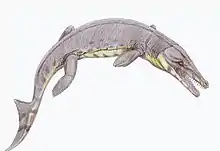Stomatosuchus
Stomatosuchus (type species S. inermis) is an extinct stomatosuchid neosuchian from the Late Cretaceous (Cenomanian) of Egypt that grew up to 10 metres (33 ft) long when it was alive. Unlike most other crocodyliforms, it is difficult to determine exactly what S. inermis ate. Its flattened skull had a long, flat, lid-like snout, which was lined with small, conical teeth. The mandible may have been toothless and may have supported a pelican-like throat pouch.[1] The type, and only, specimen of S. inermis consists of a partial skull and two caudal vertebrae.
| Stomatosuchus | |
|---|---|
 | |
| Scientific classification | |
| Kingdom: | Animalia |
| Phylum: | Chordata |
| Class: | Reptilia |
| Family: | †Stomatosuchidae |
| Genus: | †Stomatosuchus Stromer, 1925 |
| Type species | |
| †Stomatosuchus inermis Stromer, 1925 | |
The only known specimen which was collected by the German paleontologist Ernst Stromer's 1911 Egyptian expedition, was unfortunately obliterated when the Munich Museum was destroyed during an Allied bombing raid in 1944.[2][3] Only photographs remain.
Gallery
 Comparison of Stomatosuchus (center) with Retodus (top) Laganosuchus (bottom)
Comparison of Stomatosuchus (center) with Retodus (top) Laganosuchus (bottom) Skull seen from two angles
Skull seen from two angles
References
- Naish, D. 2002. Fossils explained 34: Crocodilians. Geology Today 2: 71-77.
- Stromer, E. (1925). Ergebnisse der Forschungsreisen Prof. E. Stromers in den Wüsten Ägyptens. II. Wirbeltier-Reste der Baharije-Stufe (unterstes Cenoman). 7. Stomatosuchus inermis Stromer, ein schwach bezahnter Krokodilier und 8. Ein Skelettrest des Pristiden Onchopristis numidus Haug sp. Abhandlungen der Bayerischen Akademie der Wissenschaften, Mathematisch-naturwissenschaftliche Abteilung 30(6): 1–22.
- Sereno, P. C.; Larsson, H. C. E. (2009). "Cretaceous crocodyliforms from the Sahara". ZooKeys. 28 (2009): 1–143. doi:10.3897/zookeys.28.325.

